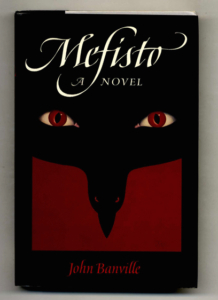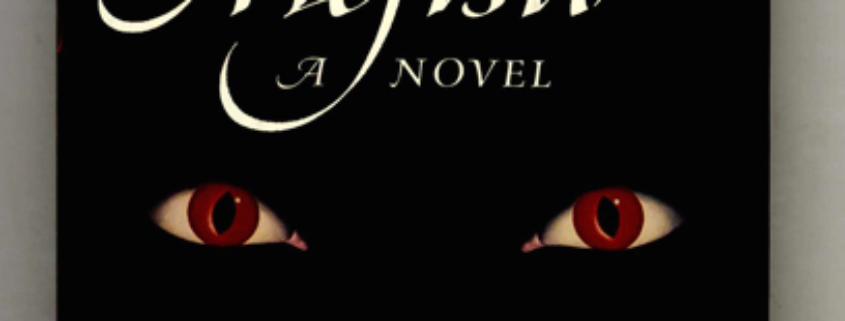Writers Read: Mefisto by John Banville
 This is a novel written by an author in extremis, an author both blessed and possessed. John Banville admits to experiencing a nervous breakdown while writing the book. He called it his attempt to set himself free in the practice of writing.
This is a novel written by an author in extremis, an author both blessed and possessed. John Banville admits to experiencing a nervous breakdown while writing the book. He called it his attempt to set himself free in the practice of writing.
The story is a first-person narration in the past tense. It is set in Ireland after World War II in a town called Ashburn—which sounds and looks like Hell, with 12,000 souls and an anthracite mine turned garbage dump—and opens with the birth of twins: one surviving, one not, one immortal, one not, like the Dioskouri. The narrator, the survivor of the two baby boys, Gabriel Swan, (as in Leda and Zeus) is the haunted, hunted, shadowed, wrung out, literally gone to hell- and-back young man who proves to be a lying, guilt-ridden, unreliable narrator. He claims to be “omniscient, sometimes.” He’s a math wiz and obsessed with numbers. His mother and teachers are more frightened and suspicious of his talent than encouraging.
He is friendless until he wanders into the hands of the devil made man, Felix. Felix, as irresistible a devil that ever was, is one of the most entertaining, profane, clever characters in modern fiction, even if Banville is heavy handed in evoking him. As the devil, he knows everything except the one thing that only God knows, which is what everyone in the novel and world would like to know: the big plan, the grand pattern. Felix provides Gabriel with two close companions in each of the two sections of the book: a damaged, attractive female and a scientist. The girls (one deaf and one drug addicted) act as bait and are used for sex, and the scientists aid Gabriel in his search for the formula to things. Felix, who strives for “rules, order, certainty,” is followed by an archangel. He’s after what Gabriel is searching for: the hidden pattern. Both characters believe that mathematics is the portal. The two scientists/professors who have been coerced by the devil to help in the endeavor have become burnt out.
As the devil, he knows everything except the one thing that only God knows, which is what everyone in the novel and world would like to know: the big plan, the grand pattern.
The novel is divided into two sections: Marionettes and Angels. In the first, Gabriel and the other two enlistees fail to discover the answers the devil is after, and fall to Hell after D’Arcy, the “messenger boy” from Heaven, drives Felix out of town. In the second section, Gabriel, who is the immortal twin, emerges scarred and disfigured from his burns. Once again, he is befriended by Felix and guided into a more populated, sophisticated, vicious world, same town though, and urged to use his genius for numbers to solve the riddle of the world using a computer. He is told that computers know nothing they have not been told. He discovers that nothing is certain but chance, and the novel ends on the same word it begins on.

John Banville, photo by Derek Speirs
At the start of the novel, the descriptive passages are painterly. Gabriel remembers his mother and his childhood town as darkened, varnished antique portraits. The wreck of Ashburn is perfectly evoked through the sense of putrid smells, and “the whites of his eyes were soiled,” suffices for Felix. When he and Gabriel turn into “Goat Alley” and a rat scuttles in front of them, “dragging a fish-head in its teeth,” and it’s daytime, the reader comprehends what may be in store. The macabre scene of Gabriel identifying his mother’s body is rendered with humor when he can’t decide if the first body he’s shown is his mother or not, and then with horror when he views his mother, “there was something in the way she was lying, all bundled up like that, as if she had been snatched up and shaken violently, and everything inside her was broken and in bits.”
As hideous and nightmarish as the story is, the style of the prose is poetic and multifaceted. The magic of the book is that while it is cynical and disgusting, it is perfectly composed. I was awed by the author’s rich use of references and symbols: from the Greeks to the Romans, the Old and New Testaments, Shakespeare and Keats, and on to Walt Disney and Andrew Lloyd Weber. But then the devil sees and knows all: almost.


 Mary Kay Wulf is currently enrolled in the MFA Creative Writing Post Development Semester with Steve Heller at Antioch University Los Angeles. Her mentors have included Alistair McCartney, Jim Krusoe, and Peter Selgin. She has an MFA from the University of San Diego/Old Globe Theatre Professional Actor’s Training Program, and holds a BA in Musicology from the University of Hawaii. She lives in Los Angeles and is working on her first novel.
Mary Kay Wulf is currently enrolled in the MFA Creative Writing Post Development Semester with Steve Heller at Antioch University Los Angeles. Her mentors have included Alistair McCartney, Jim Krusoe, and Peter Selgin. She has an MFA from the University of San Diego/Old Globe Theatre Professional Actor’s Training Program, and holds a BA in Musicology from the University of Hawaii. She lives in Los Angeles and is working on her first novel.


